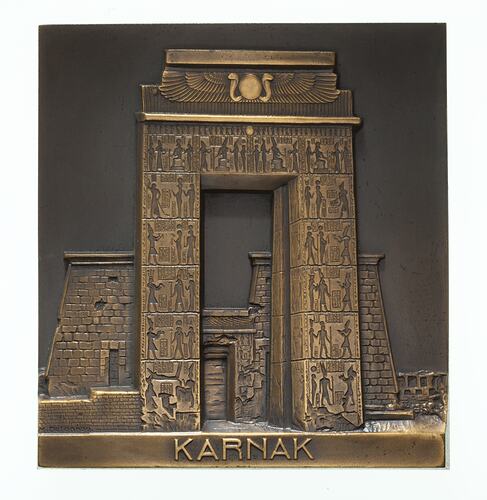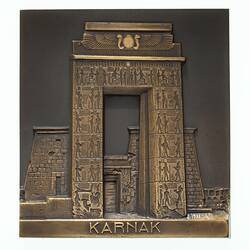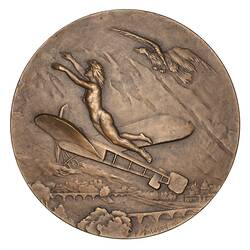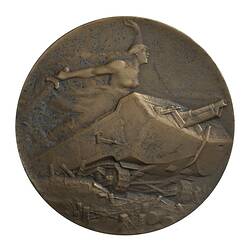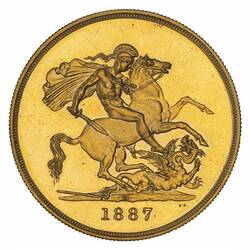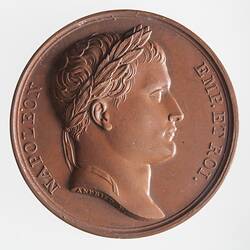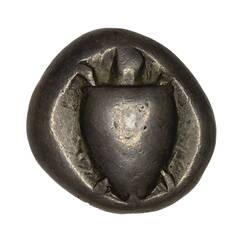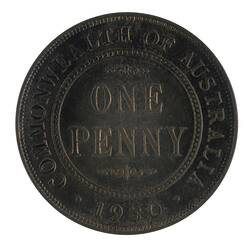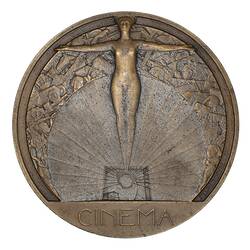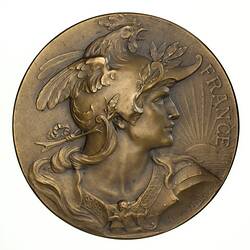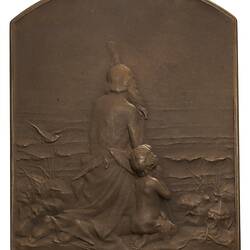Bronze medals and plaques minted in France and Belgium in the late 19th and early 20th centuries show artistic expression while not necessarily commemorating military or sporting achievements. More than shiny discs of metal, they are filled with meaning and capture emotion, beauty and poignance - even though their exquisite miniature sculpting is less than 1 millimetre deep.
Egyptomania
Already a place veiled in allure and mystery, the rediscovery of the Pharaoh Tutankhamun's tomb in 1922 created a worldwide obsession with Egypt that continues today. Ancient Egyptian art and architecture captivated Europeans and influenced home decoration for decades.
One example of an ornament made for the home is an intricate bronze plaquette depicting the Temple Gate to a building complex at Karnak in Upper Egypt (NU 34435). Each ancient Egyptian carving on the gate has been accurately captured by the artist.
Commemorative
The turn of the 20th century brought with it a fascination in the new technologies of electricity, cinema (NU 34464), radio, and flight. The French Bleriot XI aircraft was the first to fly across the French-English Channel in 1909 (NU 20843).
Meanwhile, the forces of the natural world and dangers faced by those working at the sea could have a devastating impact on human life (NU 34452). Sadness is visible on the face of a wife as she looks towards the ship sinking in rough seas on a plaque by Prud'homme. On the reverse, groups of women wearing shrouds walk towards a chapel to mourn.
Allegory and Symbolism
Being restricted by a single scene, artists have long used symbolism and allegory to illustrate ideas and communicate complex stories on medals and plaques.
The Coq Gaulois ('Gallic Rooster') came to prominence during the French Revolution. It can be seen on the helmet of Marianne, the personification of the French Republic (NU 20829). She was used again in the World War I medal by Morlon, flying as an armed Fury above a newly developed tank, the Saint-Chamond (NU 20844).
The plaque 'Salut au Soleil' (NU 20828) depicts an old man and child viewing a sunrise. The reverse contains a verse from the poem Le Vallon ('The Valley') by Alphonse de Lamartine (1790-1869) published in 1820, exploring the magnificence of nature and the presence of God in the natural world.
Lamartine writes, 'In the midst of nature, therefore, discover its creator.'
References
Sharples, JP (1990), Medals As Art: Australia and the Meszaros Tradition, Museum of Victoria and Royal Australian Mint, Melbourne
More Information
-
Keywords
-
Authors
-
Article types
